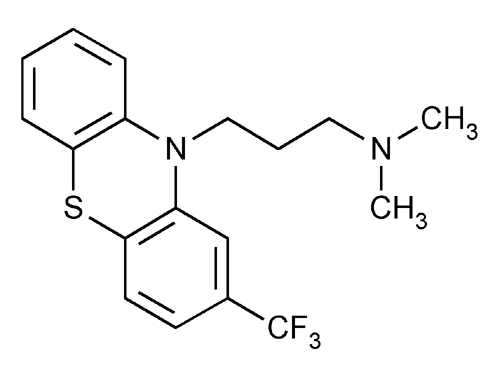Triflupromazine
10H-Phenothiazine-10-propanamine, N, N-dimethyl-2-(trifluoromethyl)-.
10-3-(Dimethylamino)propyl-2-(trifluoromethyl)phenothiazine
» Triflupromazine contains not less than 97.0 percent and not more than 103.0 percent of C18H19F3N2S.
Packaging and storage—
Preserve in tight, light-resistant containers.
USP Reference standards  11
11 —
—
USP Triflupromazine Hydrochloride RS.
USP Triflupromazine Hydrochloride RS.
note—Throughout the following procedures, protect test or assay specimens, the Reference Standard, and solutions containing them, by conducting the procedures without delay, under subdued light, or using low-actinic glassware.
Identification—
A:
It meets the requirements under Identification—Organic Nitrogenous Bases  181
181 , USP Triflupromazine Hydrochloride RS being used, and 0.01 N hydrochloric acid being used in place of water to dissolve the specimen.
, USP Triflupromazine Hydrochloride RS being used, and 0.01 N hydrochloric acid being used in place of water to dissolve the specimen.
Solution:
7 µg per mL.
Medium:
0.5 N sulfuric acid.
Absorptivities at 255 nm do not differ by more than 3.0%.
Residue on ignition  281
281 :
not more than 0.2%.
:
not more than 0.2%.
Ordinary impurities  466
466 —
—
Test solution:
acetone.
Standard solution:
acetone.
Eluant:
a mixture of chloroform and methanol (4:1).
Visualization:
1.
Assay—
Dissolve about 800 mg of Triflupromazine, accurately weighed, in 100 mL of glacial acetic acid. Add crystal violet TS, and titrate with 0.1 N perchloric acid VS to a blue endpoint. Perform a blank determination, and make any necessary correction. Each mL of 0.1 N perchloric acid is equivalent to 35.24 mg of C18H19F3N2S.
Auxiliary Information—
Please check for your question in the FAQs before contacting USP.
Chromatographic Column—
| Topic/Question | Contact | Expert Committee |
| Monograph | Ravi Ravichandran, Ph.D.
Senior Scientist 1-301-816-8330 |
(MDPP05) Monograph Development-Psychiatrics and Psychoactives |
| Reference Standards | Lili Wang, Technical Services Scientist 1-301-816-8129 RSTech@usp.org |
USP32–NF27 Page 3801
Chromatographic columns text is not derived from, and not part of, USP 32 or NF 27.
